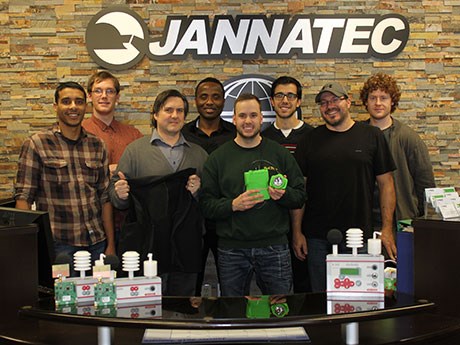Improved safety and comfort in store for miners working at depth
Jannatec Technologies is well on its way toward revolutionizing the clothing and personal protective equipment used in the mining industry.
Long known for its Johnny Light radio cap lamp, Sudbury-based Jannatec is working on a research and commercialization project with the Ultra Deep Mining Network to address the issues of worker safety and productivity in deep underground mines, where temperature and humidity levels are risk factors for heat stress.
A modular solution customizable for different working conditions could incorporate two-way radio communication, RFID tags for location tracking and collision avoidance, integrated with new thermally efficient coveralls, a cooling vest and wide range of sensors to measure skin temperature, heart rate and environmental conditions, including temperature, humidity and air pressure.
Data collected by the sensors would be transmitted wirelessly through a mine’s communication infrastructure to surface, and would activate and control a personal thermal-electric cooling vest.
A power and data backbone or network will be integrated into the garment to connect all the peripherals.
Due to auto compression, the air in a mine heats up an additional nine degrees Centigrade every kilometer, said Jannatec senior research scientist Steffon Luoma. Depending on the location, it’s not unusual for miners to be working in temperatures of 30 to 40 degrees Centigrade and with humidity levels of 80 to 90 per cent.
These conditions put miners at risk of heat stress, which can cause exhaustion, disorientation, vision problems and loss of consciousness. Currently, miners working at extreme depths are required to conform to a work–rest regime.
“The guidelines can have them working 25 per cent of the time and resting 75 per cent of the time just to make sure they’re safe,” said Luoma.
With clothing designed for thermal efficiency and cooling vests to lower core body temperature, Jannatec is confident it can to improve worker safety and dramatically increase productivity.
“If we can get people to work an extra 15 minutes per hour, we can double productivity,” said Jannatec president Wayne Ablitt.
Jannatec is partnering with several academic institutions including world-class experts in thermal physiology to develop the technology required for predicting the onset of heat stress.
“Currently, most of the mechanisms used to determine heat stress are invasive and it’s hard to get an accurate reading using sensors,” said Luoma. “The objective is to develop an algorithm that will take the data from the sensors and use it to estimate when a person is under heat stress. The current one-size-fits-all guidelines for work-rest are not individualized. Some people are different in terms of how they tolerate heat. A miner, for example, can be older or diabetic. In the interest of safety and productivity, it’s really important that we individualize the work-rest cycle.”
Jannatec is also working with experts in textiles and garments to re-engineer the coveralls worn by miners.
“Everyone thinks the coveralls we use today do a good job, but the tests we’ve done and the people we’re working with tell us that the cotton-polyester blend material in use today doesn’t allow sweat and heat to come off the body,” said Ablitt. “It’s not designed for thermal comfort.”
The choice of material and the design of the coveralls being developed by Jannatec will borrow heavily from the active sportswear industry, which has come along way in the last 15 years, said Luoma.
Ablitt won’t divulge any further details about the personal thermal-electric cooling vest currently in development, but notes that it will be vastly better and more practical then vests containing ice, which are heavy and only effective for a few hours.
The sensors and tracking devices will work with both Wi-Fi and leaky feeder communication infrastructure.
“A lot of mines are embracing technology and moving more and more to Wi-Fi,” said Jannatec research and development manager Jason Buie. “Some are fairly well covered and the others are spotty, so we have to be able to utilize either or both types of infrastructure.”
The solution Jannatec is working on is designed to be modular in nature, allowing mines to select the components and peripherals dictated by the working conditions. Miners working closer to surface may not require a cooling vest and biometric sensors, for example, but would be more comfortable with redesigned coveralls incorporating various communication and safety related devices.
Mining isn‘t the only industry Jannatec is targeting. According to Ablitt, the solution will also be effective for soldiers and firefighters working in harsh conditions.
The heat stress solution being worked on by Jannatec is one of 24 research and commercialization projects under the umbrella of the Ultra Deep Mining Network, a federal government supported Business-Led Network Centers of Excellence program managed by the Center for Excellence in Mining Innovation.
Jannatec expects to begin marketing its heat stress solutions by mid-2017.
Established in 1989, Jannatec is part of the Schauenburg Group of Companies, which has 1,700 employees, annual sales of $450 million and 37 offices worldwide.



